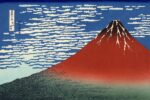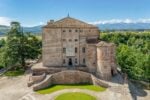Sophie Ko Chkheidze – Geografie temporali
 (480x437).jpg)
Mostra personale di Sophie Ko Chkheidze (Tbilisi, 1981) artista georgiana che vive e lavora a Milano.
Comunicato stampa
Sabato 8 ottobre alle ore 18.00 lo spazio della Galleria de' Foscherari di Bologna si apre per ospitare la mostra personale di Sophie Ko Chkheidze (Tbilisi, 1981) artista georgiana che vive e lavora a Milano.
In questa mostra a cura di Federico Ferrari sono presentati i seguenti lavori: Kaspar Hauser, L'uomo accende a se stesso una luce nella notte, Atlanti (polittico), Terra (polittico).
Tutte le opere esposte sono Geografie temporali (a eccezione di Kaspar Hauser) ovvero quadri fatti di cenere di immagini bruciate o di pigmento puro che costituiscono il momento più intenso della riflessione poetica dell'artista sulle immagini. L'intera opera di Sophie Ko è incentrata sul senso delle immagini nella nostra vita e le Geografie temporali per la forza espressiva e per l’essenzialità della potenza figurativa entrano in dialogo con alcuni momenti fondativi della storia (e della pre-istoria) dell'arte.
Terra, è il titolo di questa mostra e le opere esposte appaiono come il tentativo di riportare alla visibilità la terra, di ridarne senso in immagine. Il processo di illimitato ampliamento della ratio tecno-economica è giunto al punto di rendere invisibile proprio la terra stessa che vale ora solo come supporto di tale processo. Le immagini sono diventate vuote di senso perché non vediamo nemmeno più la terra. Nelle opere di Sophie Ko la terra torna a essere ciò che è, uno dei quattro elementi del cosmo, il fondamento della nostra vita.
Siamo accolti nella prima sala dalla Geografia temporale intitolata L'uomo accende a se stesso una luce nella notte, frammento eracliteo che ci invita a riconoscere la luminosità dell'immagine (e della nostra anima) nel grigio-nero della cenere di immagini bruciate. Nel prendere forma della cenere L'uomo accende a se stesso una luce nella notte mette in scena il rapporto tra tempo e immagine fatto di pressione e di distruzione del tempo sulle immagini, ma anche di formazione, profondità, rinascita delle immagini rispetto alla furia distruttrice del tempo. La Geografia temporale mette dinanzi ai nostri occhi che l'immagine non soltanto subisce il tempo, ma segna il tempo, lo porta a una forma, dà un senso e una direzione al nostro sguardo su questa terra.
Le cinque Geografie temporali di cui si compone Atlanti fanno apparire dinanzi a noi la terra come grandi scogli che paiono dialogare con La scogliera sulla costa di Caspar David Friedrich: siamo giunti al limite della terra e solo ora la terra torna visibile come luogo da raggiungere, come scabra terra promessa, che chiede di essere abitata. Nell'azzurra lontananza degli scogli misuriamo la distanza che ci separa da essa.
Nella sala delle tredici Geografie temporali di Terra siamo avvolti nella profondità della terra: procediamo immersi nella terra, come il cavaliere düreriano non possiamo più guardare dall'alto in basso le radici degli alberi, perché ora sono all'altezza della nostra testa. Torniamo a vedere la terra perché siamo sprofondati dentro di lei, ci troviamo nel fondo di un sepolcro. La terra ora ci si mostra non tanto grazie alla sua lontananza sublime, ma perché siamo avvolti in lei: «Terra sei e terra tornerai». A noi è lasciata la possibilità di costruire un nostro viaggio che iniziando dentro la terra, passo dopo passo, ci riporti alla luce, alla Gerusalemme celeste, meta del cavaliere di Dürer.
Il riconoscimento della terra è al centro anche dell'acquerello Kaspar Hauser, l'unica opera in mostra in cui la dimensione figurativa della mano torna al centro dell'immagine. La figura mitica di Kaspar Hauser è il simbolo della esistenza umana: un viaggio incerto nella vita come quello di Kaspar si trasfigura nell'uomo su una piccola imbarcazione, che avvolto dal bianco, in silenzio si muove alla ricerca della propria terra. La terra non è ancora visibile, ma è quella la direzione del viaggio. Nella figura di Kaspar Kauser si riflette il movimento ellittico della vita umana: per ogni uomo, come scrive Georg Trakl, «un bene e un male sono preparati».
On Saturday october 8th at 6 pm the Galleria de’ Foscherari will be presenting a solo exhibition by Sophie Ko Chkheidze (b. 1981 in Tbilisi), a Georgian artist who lives and works in Milan.
The show curated by Federico Ferrari will include the following works: Kaspar Hauser, L'uomo accende a se stesso una luce nella notte, Atlanti (polyptych), and Terra (polyptych).
All of the pieces on view (with the exception of Kaspar Hauser) belong to the artist’s Temporal Geography series: paintings made with the ashes of burnt images, or with pure pigment, constituting the most intense phase in the artist’s poetic reflection on the image. All of Sophie Ko’s work revolves around the question of what images mean in our lives, and her Temporal Geographies, with their expressive energy and undiluted figurative power, enter into dialogue with certain fundamental moments in the history (and prehistory) of art.
Terra (Earth) is the title of this exhibition, and the works it presents are an attempt to restore visibility to the earth, to give it new meaning as image. Images have been emptied of meaning because we no longer even see the earth. The unbridled expansion driven by a techno-economic rationale has reached the point that the earth itself has become invisible, valued only as the basis for this process. In the works of Sophie Ko, the earth is once more what it is, one of the four elements of the cosmos, the foundation of life itself.
In the first room we are greeted by the Temporal Geography titled L’uomo accende a se stesso una luce nella notte (Man Kindles a Light for Himself in the Darkness), inspired by a fragment from Heraclitus, which invites us to see the radiance of the image (and of our spirit) in the gray-black ash of burnt images. Rising out of ashes, L'uomo accende a se stesso una luce nella notte embodies the relationship between time and image, in which time exerts a destructive pressure on images, yet images also form, gain depth, and are reborn out of the ravaging fury of time. The Temporal Geography lets us see how the image not only endures time, but marks time, channels it into a form, gives meaning and direction to our vision of this earth.
The five Temporal Geographies comprising Atlanti (Atlases) make the earth loom before us in the form of giant outcroppings, echoing Caspar David Friedrich’s Rocky Reef on the Sea Shore: we have reached the ends of the earth, and only now does the earth become visible again as a destination to be reached, a stark promised land, calling us to dwell there. In the blue distance of the rocks, we measure its remove.
In the room with the thirteen Temporal Geographies of Terra, we are plunged into the depths of the earth: we move forward engulfed in it, like Dürer’s knight, unable to look down at the tree roots, because they are now level with our heads. We see the earth once more because we have sunken into it, we are at the bottom of a tomb. The earth now reveals itself to us not through its sublime distance, but because it surrounds us on all sides: “for dust thou art, and unto dust shalt thou return.” We are left with the possibility of forging our own path, which begins within the earth, and step by step leads us back into the light, toward the Heavenly Jerusalem, the goal of Dürer’s knight.
Recognition of the earth is also the underlying theme of the watercolor Kaspar Hauser, the only work on view in which the figurative dimension of the hand is once again at the heart of the image. The legendary figure of Kaspar Hauser symbolizes human existence: Kaspar’s uncertain journey through life is transformed into a man on a small boat, shrouded in the whiteness and silence, moving off in search of his own land. The earth is not yet visible, but that is the direction of the voyage. Kaspar Hauser’s figure reflects the elliptical course of human life: for every human being, as Georg Trakl put it, “both evil and good have been prepared.”



